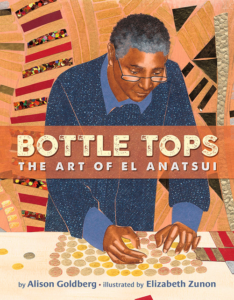Reviewed by Veronika Jenke
Reviewed Source: Africa Access
Book Author: Alison Goldberg
The picture book Bottle Tops: The Art of El Anatsui introduces El, as he calls himself, and his innovative process of creating massive assemblages that are both textile-like and sculptural. A living artist born in Ghana, West Africa, El lives, teaches and works as an artist at the University of Nsukka in Nigeria, West Africa. He has built an international reputation for his unusual, monumental works created with non-traditional (discarded) materials. On this side of the Atlantic, one might be tempted to muse that this artist is working with discarded materials because he doesn’t have access to “real” art materials. But that reasoning would be falling into a stereotypical trap. El has chosen his material quite deliberately because it allows him to explore issues that are front and center for an artist like El: the histories of Ghana and Nigeria linked to Africa’s colonial legacy, as well as the trans-Atlantic slave trade, consumerism, and the very pressing issues of the environment. Some of these issues confront not only African artists, but artists the world over.
Author Alison Goldberg relates El Anatsui’s formative artistic and educational experiences which included drawing, plaster casting, and painting, art forms based on European artistic traditions. When El Anatsui began his schooling, his country — known then as the Gold Coast — was still a British colony. Its educational system was based on a British model and the art curriculum focused on European art and history, to the exclusion of African art and history. After independence in 1957, El attended the Kwame Nkrumah University of Science and Technology (KNUST), where he studied art and education. Subsequently he became lecturer at the then Specialist Training College, now University of Education in Ghana. At the age of 32, with university degrees in hand, he moved to Nigeria to begin a forty plus year career teaching art at the University of Nsukka where he joined other notable Nigerian artists. As an artist he began his search for his own artistic heritage by working in ceramics and wood, as well as painting and printmaking. Continue reading on Africa Access.

Bottle Tops by Alison Goldberg
Published by Lee & Low Books on 2022
Genres: Africa, Art, Biography and Autobiography
Pages: 40
Reading Level: Grades 1-2, Grades 3-5
ISBN: 9781620149669
Review Source: Africa Access
Publisher's Synopsis: Editor's Choice Books for Youth, Booklist Editor's Choice Books for Youth, Booklist Children's Africana Book Awards, Howard University Center for African Studies winner
The inspiring biography of Ghanaian artist El Anatsui whose handmade sculptures, created from discarded bottle tops, have received international acclaim and been showcased around the world.
"If you touch something, you leave a charge on it and anybody else touching it connects with you, in a way." — El Anatsui
El Anatsui has always written his own story. As an art student at the University of Ghana, El noticed that the artists and styles he was studying were grounded in European traditions. Curious about his own culture's art history, El observed his people and found stories in the fabrics they wore and the way they used recycled goods. He decided to tell these stories through his artwork.
El experimented with different mediums — firing broken clay into new pots and cutting wood into sculptures using a chainsaw. Each time El tried something new, he brought with him the experience of all the experiments he did before. After coming across a discarded bag of shimmering bottle tops, El wondered What was their story? He experimented with the new material — disassembling, flattening, and reshaping — then stitched the tops together with wire. The result were large, flowing tapestries that tell stories about history, culture, and link people together. Today, El's bottle top sculptures are showcased all over the world inspiring audiences everywhere.
Here is the captivating story of a Ghanaian sculptor whose passion, creativity, and awe-inspiring artwork reminds us that creating powerful art is about being true to yourself.

Leave a Reply